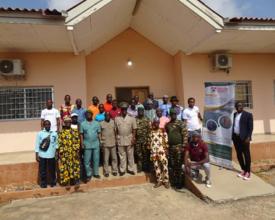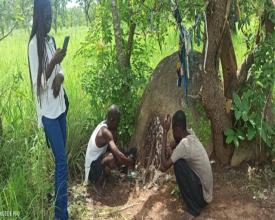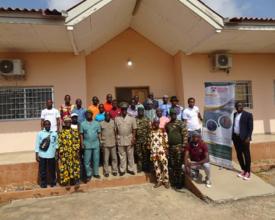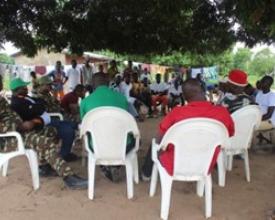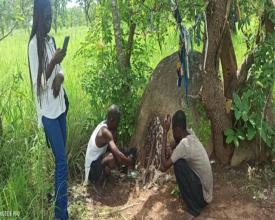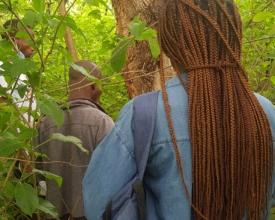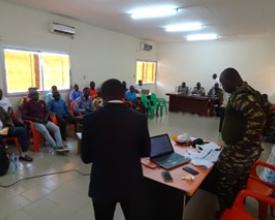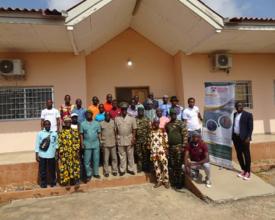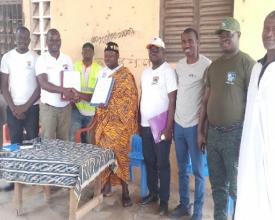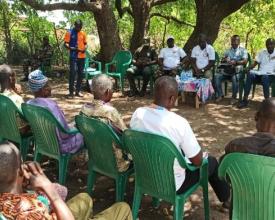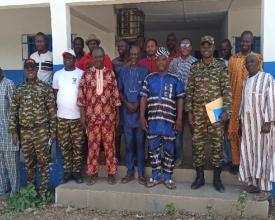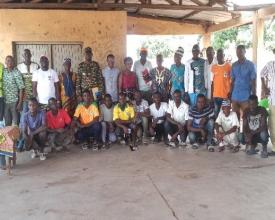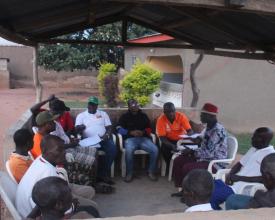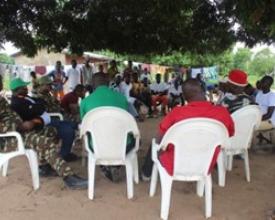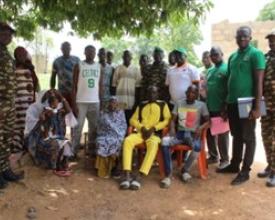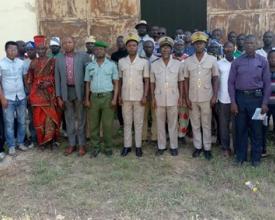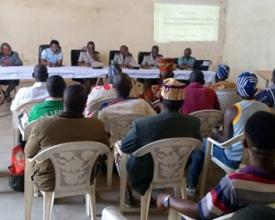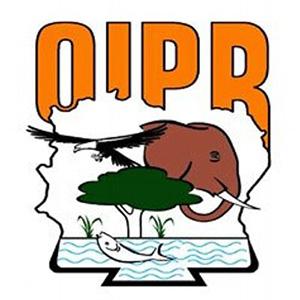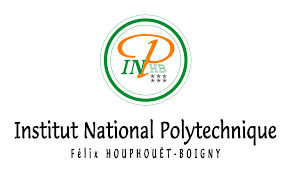
Involvement of local communities in the participatory management of Comoé National Park as part of the Green List application process
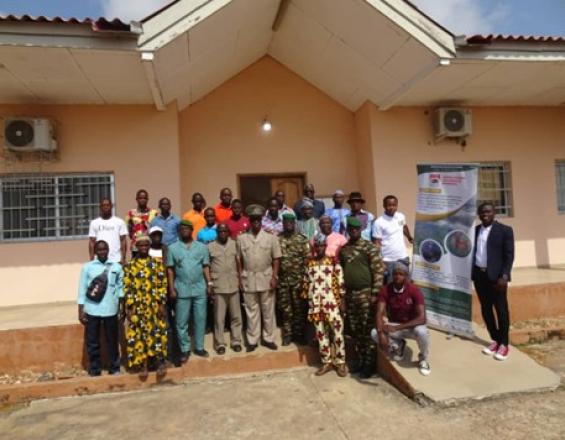
In the process of nominating the Comoé National Park (CNP - WDPA ID: 7523) for the IUCN Green List, shortcomings were noted in the involvement of communities in site management, particularly in terms of criteria 2.1 " Identify and understand the main values of the site, notably ecosystem services and cultural values ". To address this weakness in site management, OIPR/DZNE received support from GIZ's Programme de gouvernance et de gestion des Ressources naturelles (Pro2GRN). The activities undertaken as part of this support have led to the signing of several agreements for access to sacred sites in the Comoé National Park, with a view to conserving these values.
Context
Challenges addressed
The Ivorian Protected Areas Management Act prohibits any right of resource use by local communities, but requires them to be involved in management. What is the interface between conservation and use of the protected area?
In its ongoing relations with communities, OIPR DZNE attaches great importance to cultural and cultic rites. This interest is part of an approach aimed at better conservation of its heritage and improving the living conditions of the surrounding populations. Local populations consider the park to be the resting place of their cultural relics left by their ancestors. The OIPR DZNE has always facilitated access by local residents to these sites for their rituals, through the granting of authorizations. To improve this practice, the manager intends to formalize it through an agreement to crystallize the parties' commitments. The aim of this process is to develop long-term ecotourism.
Location
Process
Summary of the process
The participation of local communities in the management of the Comoé National Park (CNP) has been the goal of achieving conservation objectives. A study identified existing worship sites in the PNC. To formalize the practice of worship in the PNC, a model convention was adopted during a consultation workshop with community representatives and prefectoral authorities. The content of the convention and its rationale were explained to the communities concerned during an awareness-raising tour, at which the conventions were signed.
This participatory process culminated in the signing of some thirty access agreements for sacred sites in the Comoé National Park with local communities, reinforcing trust between the manager and the local population and contributing to the preservation of the protected area.
An assessment of the first year's implementation of the agreements was carried out, enabling implementation difficulties to be discussed and solutions found.
Building Blocks
1. Information and data collection through studies on the contribution of socio-cultural practices to the revival of ecotourism in Comoé National Park
The first stage focused on carrying out a study to identify cult sites in the PNC and surrounding villages.
OIPR's North-East Zone Management plans to boost ecotourism in the Comoé National Park (CNP). To this end, a strategy has been defined to promote the traditional practices of local residents for tourism purposes. Taking into account the history of the creation of the PNC, it is known that it inherited sacred sites in the interior, for which little information is available. With this in mind, a study by the Institut National Polytechnique Félix Houphouët Boigny entitled "Contribution des pratiques socio-culturelles à la relance de l'écotourisme au Parc national de la Comoé" (Contribution of socio-cultural practices to the revival of ecotourism in the Comoé National Park) was initiated, with the aim of gathering information on cultural sites and attractions that could contribute to the revival of ecotourism in the CNP.
Enabling factors
One of the success factors was the willingness of land chiefs and traditional guarantors to provide information during the study surveys.
The results obtained show that the CNP contains a diversity of sites, and that the populations of its peripheral zone (ZP) have cultural attractions that can contribute to the revival of ecotourism in the CNP. In the Bouna sector, thirty-six (36) sacred sites have been identified, twenty-one (21) of which are in the park and fifteen (15) on its periphery, and thirty (30) sites in the Nassian sector, twenty-two (22) of which are in the park and the other eight (8) on its periphery.
However, problems linked to their devaluation have been identified. To meet this challenge, objectives have been defined, and to ensure that these practices contribute to the revival of ecotourism, two strategic axes have been identified. These are (i) the collaboration and motivation of local residents and (ii) the promotion of cultural tourism by the manager.
Lesson learned
Local communities remain strongly linked to Comoé National Park through the cult sites that exist there, and are committed to preserving and enhancing them.
2. Validation of a model agreement on access to sacred sites in the CNP with communities in the presence of local authorities.
The workshop to validate the agreement on access to the PNC as part of the worship of sacred sites was attended by a number of players, including the prefectoral authorities, GIZ, the villages bordering the Bouna and Nassian sectors, and local radio stations. This meeting required perfect coordination between the DZNE and its partner GIZ/Pro2GRN.
Enabling factors
This phase required a preparatory phase, which involved drawing up and validating the terms of reference and the draft agreement for access to the sites. The OIPR-DZNE team presented the draft agreement to all participants. Two (2) working groups were set up to scrutinize the agreement already drawn up for comments (Suggestions and recommendations).
Each group presented the results of its discussions. The suggestions and recommendations made during the plenary sessions on the draft convention were presented and discussed.
The workshop thus enabled the model convention for access to the CNP in the context of the worship of sacred sites to be reviewed in its entirety, the opinions of the stakeholders were collected and taken into account in accordance with the management rules of the National Parks and Nature Reserves of Côte d'Ivoire, and the model convention for access to the CNP in the context of the worship of sacred sites was validated.
Lesson learned
The study carried out to identify sacred sites in the CNP identified riverside villages with existing sites in the protected area and a need to revive these practices. This facilitated the mobilization of these villages for the validation of the model agreements.
3. Signing of agreements with the communities of the villages of Bouna and Nassian for access to the PNC as part of the worship of sacred sites.
At the end of the workshop, all the points of the model agreement were validated by the stakeholders present. The next stage of this important activity was therefore the organization of meetings with the communities of the various villages concerned in the Bouna and Nassian sectors to discuss any difficulties they might have in implementing the convention for access to the PNC for the purpose of worshipping sacred sites, followed by the signing of the convention in the villages visited.A meeting tour with the communities of each village whose representatives were present at the December 2022 consultation workshop was carried out to discuss the implementation of the convention for access to the PNC in the context of the adoration of sacred sites, and to proceed with its signature. The tour was attended by the OIPR/DZNE (the North-East Zone Director, the Project Manager, the Riparian Measures Manager, the Chiefs of the sectors and rural animators concerned) and the Biodiversity and Forests Expert from GIZ/Pro2GRN. There was a massive response from the local population, with village and land chiefs and their notabilities warmly welcoming the delegation.
Enabling factors
The visit to each village lasted a maximum of 2h30mn, and the main activities included a welcome, installation and presentation of courtesies, a reminder of the context, objectives and rationale of the agreement, a reading and explanation of the agreement's content, the adoption and signing of the agreement by both parties, with a copy being given to each village, and discussions on other aspects of relations between the OIPR and local communities. Some twenty agreements were signed during the tour.
Lesson learned
Pre-validation of the agreement model with the community representatives concerned during the consultation workshop and their presence during the tour facilitated exchanges and understanding of the content by all the communities, which in turn facilitated their support and the signing of the agreements by their representatives. Sites in other sectors (Tehini, Dabakala, Kong) need to be inventoried in order to sign new agreements with these villages.
4. Mission to monitor the implementation of agreements for access to the PNC as part of the worship of sacred sites in the Bouna and Nassian sectors, and to scale up to all villages on the outskirts.
Following the signing of access agreements to the PNC for the worship of sacred sites, and after months of implementation, a monitoring mission was carried out in the field to identify the difficulties encountered in implementing the agreements and how to remedy them, the planning of visits to sacred sites in the PNC by all partner villages, and the status of villages that had not made any visits. In addition to the monitoring mission, discussions were held with the customary authorities of the villages bordering the Tehini sector, to gather information on the possibility of extending the sacred site access agreement to the Tehini sector. Twenty (20) sacred sites were inventoried in collaboration with communities in seven (07) villages in the Tehini sector, where certain communities have expressed the need to access sacred sites within the PNC for their worship.This mission was led by the OIPR/DZNE (the Chargé d'Etudes at the DZNE, the Chiefs of the Bouna, Nassian and Tehini sectors, rural animators and community relays from the sectors concerned) and the Biodiversity Expert from GIZ/Pro2GRN.
Enabling factors
During the follow-up, it was noted that some villages had performed adoration in the PNC to implore the manna (35 adoration activities for 03 of the 17 villages that had signed the conventions). As for the other villages, they hailed the convention's initiative and added that, for the most part, no events requiring adoration had occurred since the conventions were signed. During the discussions, some villages pointed out that there had been a break between them and their manna for a very long time. As a result, there is no immediate need for worship. For them, sacrifices will have to be made before they can resume their ancient practices.
This stage enabled the identification of new partner villages, namely 08 (eight) villages in the Tehini sector (31 sites identified) and 04 (four) villages in the Nassian sector (08 sites identified), which have sacred sites in the PNC and would welcome collaboration in the worship of sacred sites.
In addition to the mission, data was collected from the local population in order to compile a list of useful plants that had disappeared, and the reasons for this in their territories.
Lesson learned
The formalization of access to sacred sites has enabled local populations to renew contact with their spirits. However, for some villages that had abandoned these practices, the resumption of worship requires material and financial resources. New partnerships also need to be signed with new sites identified in other villages. These agreements build trust between managers and local populations, opening up new prospects for collaboration, such as the participatory preservation of utilitarian plants and their domestication for future generations.
5. Mid-term review of the implementation of the OIPR DZNE - riparian villages agreements for access to the PNC in connection with the worship of sacred sites
Follow-up missions to these agreements have enabled us to ascertain the level of their implementation and to initiate new partnerships. Several worship initiatives in the PNC have been carried out to seek cures, drive away evil spirits and solicit professional promotions. In all, 30 access agreements for the worship of sacred sites were signed in the localities of Nassian, Bouna and Tehini.A workshop was organized to take stock of worship activities carried out at sacred sites within the PNC by communities in each sector, to identify the advantages and difficulties associated with the implementation of the convention for access to sacred sites within the PNC, to provide the OIPR with an annual calendar of worship activities, and to formulate recommendations for improving collaboration between the signatories of this convention. The review workshop took place on December 20, 2023, in the meeting room of the Kotouba Sub-Prefecture. It brought together the Sub-Prefects of Tehini, Nassian, Kotouba and Bouna. The meeting was also attended by representatives of the villages that have signed the conventions, OIPR officials and a representative of the technical partner (GIZ/Pro2GRN).
Enabling factors
In all, thirty (30) agreements have been signed between the communities and OIPR for access to the PNC for worships in thirty (30) riverside villages. Fifty-eight (58) worships were performed in five (05) villages in 2023. Four hundred and seventy (470) people accessed the PNC during all the worship activities carried out in 2023. A few testimonials were collected from the local population during the workshop to present the benefits of the PNC access agreements.
Testimonial 1 (village of Kokpingué): fetish worship inside the PNC slowed down the succession of misfortunes that were befalling the village;
Testimonial 2 (Village of Kotouba): Several benefits of worship can be cited, the latest being the professional promotion of a state civil servant who had requested the services of the fetish and was rewarded with a high position.
Testimonial 3 (Village of Yalo): the village representative reported that drought was affecting the village, leading to crop failure. Following adoration of sacred sites, the rains were abundant and harvests were good.
A schedule of village worships was drawn up. Some of the difficulties encountered relate to access to the sites, insufficient financial resources for the worships, sites that cannot be found, and the disappearance of certain worshippers. Faced with these difficulties, OIPR DZNE and its partners intend to provide technical and financial support to find the people's sites and make the first sacrifices.
Lesson learned
A regular review framework is important to assess progress and propose solutions to remove obstacles to convention implementation.
Impacts
The signing of access agreements for sacred sites in the CNP has made it possible to fill the information gaps identified by criterion 2.1 in the IUCN Green List application process. The identification of these sites has ensured that they are available to local populations according to their needs. It has also enabled them to formally reconnect with the manna and revive ancestral practices that in some cases had been abandoned.
The various workshops and discussion tours enabled the DZNE and the local population to identify these sites in the PNC. The exercise also demonstrated the need to involve communities in the management of the park. The worship of sacred sites makes it possible to preserve a PA by taking into account the perception of local communities and their traditional knowledge.
In addition, the main conclusions of the approach highlighted the contribution of local communities in the conservation of the protected area with the formalization of sacred site worship. These conventions have once again created trust between the manager and the populations who protect their sacred sites.
This is a fine example of participatory PA management. It could be extended to other PAs in the nation's network.
Beneficiaries
Seven (07) stakeholder groups were involved:
-Protected area manager (OIPR) ;
-Local communities ;
-Tourists ;
-Civil society ;
-Private sector ;
-Researchers;
-Technical and financial partners.
Sustainable Development Goals
Story
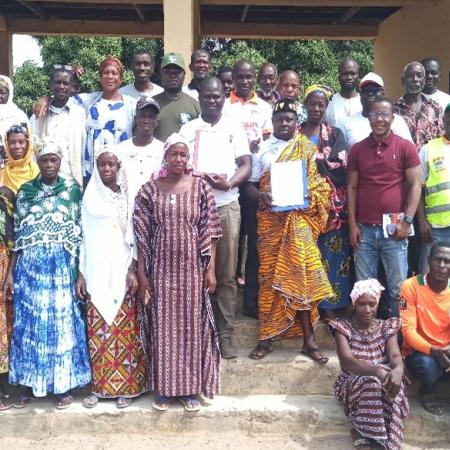
The village of Kalabo is one of the signatory villages of the PNC sacred site access agreements in the Nassian sector. In this village, the main fetish worshipped is a rock called "Katèlè Gboko". It is worshipped by the local population for its social benefits (promotion of wealth, health, childbirth, etc.). This worship is carried out with the different social strata of the village (old, young, women, children), enabling knowledge to be passed on to the next generation. For the record, in 2023, one of the village's sons, a teacher in a local elementary school, was promoted to the position of Pedagogical Adviser in Primary Education following worship of the fetish. In return, he offered a goat to the fetish in gratitude. The Kalabo village chief also implored the fetish for the return of the animals. According to him, the animals used to be visible in the village, attracting tourists, and the local population benefited from the sale of local produce. Six (06) months later, in September 2024, elephants were spotted on the edge of the village. For them, it's a ray of hope for the development of community tourism.
